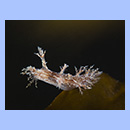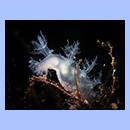- Kingdom: Animalia
- Phylum: Mollusca
- Class: Gastropoda
- Subclass: Heterobranchia
- Order: Nudibranchia
- Suborder: Dexiarchia
- Infraorder: Dendronotida
- Superfamily: Tritonioidea
- Family: Dendronotidae
- Scientific name: Dendronotus frondosus
- Norwegian: busksnegl
Characteristics:
This is one of the bigger nudibranchs in Norway, as it can reach a length of 10 cm. It comes in many different colors. Yellow, brown, red and even entirely white individuals exist. The color cannot be used for identification. A typical characteristic for the Dendronotus species is the bushy appearance of the gills on the back of the body. It can be difficult to distinguish D. frondosus from the some of the other Dendronotus species known, from Norwegian waters:
- D. frondosus has between 6 and 12 lamellae on the rhinophores (organ on the top of the head, used to "smell" chemical compounds in the water). The gills are moderately branched, they usually have secondary, but sometimes even tertiary branches. The secondary and tertiary branches have rounded tips. Many specimens have pigmented spots or stripes, but entirely white white, translucent bodies are fairly common, as well.
- D. lacteus has between 10 and 14 lamellae on the rhinophores. The gills tends to be more heavily branched. The tertiary branches are short. The tip of the secondary branches are shaped like spikes, in contrast to the rounded branches of D. frondosus. The color variation is as great as the D. frondosus, but white specimens seems to be common in Trøndelag waters. This is also reported from Sweden, by Thollesson.
- D. robustus has shorter, not so heavily branched gills, compared to the two species above. The flattened, not so slender body gives this species a more robust appearance. It is often heavily pigmented, making the body look reddish brown. White pigmented spots are scattered out over the entire body and tentacles. Close-ups will reveal fine wrinkles in the skin.
- D. yrjargul has the same color scheme as the Dendronotus sp. I found in 2005. The tip of the cerata are heavily fringed and brown pigmentations runs as two lines on the back of the white, translucent body. The rhinophores have 18-30 lamellae. Body lengths up to 10 cm have been observed.
Habitat:
It is often seen feeding on hydroids among seaweeds and algae, often on sheltered locations where there are not too much disturbance from the waves.
Distribution:
The frond eolis is common in Northern parts of both the Atlantic and Pacific oceans. In Europe it has been registered as far north as Siberia and Greenland and as far south as France.
Taxonomy:
D. frondosus and D. lacteus has been regarded as the same species for a period of time, but recent genetic studies by Thollesson (from Sweden), Ekimova (from the North East Atlantic and North West Pacific) and Stout (from the Eastern Pacific) show that these are indeed two separate species.







